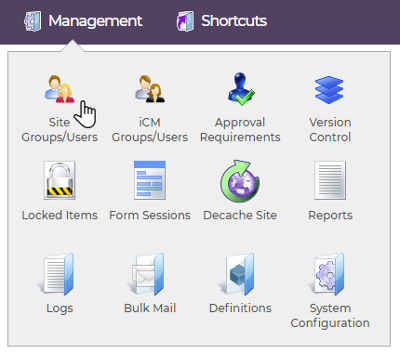
This section of iCM holds information about people who have registered with your site, or have logged in using a third party provider.
Data Protection
Site users contain personally identifiable information and personal data. Access is granted via an iCM user's Management Privileges. You should carefully consider which of your users have access, perhaps only assigning access for a limited time period when a specific task needs to be carried out.
Users, Accounts and Logins
The users you see listed in this section of iCM are the user accounts of people who have registered with or logged into your site. They uniquely identify a user and hold information about them. Accounts have a unique username - although this is not the username used to log in with.
Website user accounts have one or more logins associated with them. Logins provide the methods account users log in with. The types of login present in your site match the login providers set up and enabled in the Authentication worker and template.
For example, when a someone registers directly with your site using your registration form, iCM will create them an account and an iCM site login. If you have "login with Facebook" enabled, when someone logs in with Facebook, iCM will create them an account and a Facebook login.
New logins can also be linked to existing accounts. If someone who had registered directly with your website later logs in using Facebook, they will have the option to link their Facebook login with their existing account (after verifying they own both). The person will still only have one account, but their account will have two logins associated with it. People are able to manage their logins, adding new login methods and removing logins they no longer want to use using the My Account - Advanced Layout template.
Website user accounts have profiles. User profiles hold extra information about users, like their email address and name. User profile information is usually created during site registration and can be managed from your site's My Account article. It can also be retrieved from third party login providers if a user gives their consent.
How Users are Organised
Website users are organised into user groups. Groups are used in areas of iCM, like the article and media libraries, to secure content to sets of users.
Because most user accounts have GUID-style usernames, the trees in iCM display a combination of information taken from a user's profile, known as the Display Name. See User Settings for more information.
The user explorer menu displays user alphabetically by display name. Rather than displaying a flat list, it's generally best to categorise users by the characters their name starts with. For example:

This categorisation (ie the number of characters to use when nesting the tree) is set in the Look and Feel Settings. If you have more than 50,000 users, the tree will be forced to categorise your users by the initial letter.




